One of the lesser known regions of Italy, Marche has a long and rich history to discover and a multitude of stunning towns and villages to explore. We’ve compiled an A to Z of all those we think should be ticked off your bucket list on any Marche holiday.
Acqualagna
Acqualagna is a modern town which arguably is not particularly attractive. But it’s well worth a visit if you’re after truffles! It is the most important centre in Italy for the production and sale of truffles. Incredibly, two thirds of all the truffles in Italy come from here and one in four of all its residents are in possession of a truffle hunting license. The prized white truffle – Tuber magnatum pico – is harvested from October to December followed by the black truffle harvest – Tuber melansporum – which lasts until mid March and then by the black Summer truffle – Tuber albidum – from May until December. In other words, whatever time of year you visit, you’ll be sure to come across truffles of one form or another! However, a great time to visit is certainly during the Truffle Fair that runs annually from the last weekend of October until the middle of November. Whilst in Acqualagna, take the time to admire the 15th and 16th century frescoes in the church and visit the Pelingo Sanctuary. The latter is a spiritual sanctuary in a breathtakingly beautiful setting.
Acquasanta Terme
Acquasanta Terme is an old Roman town, initially settled in by the Romans to take advantage of the hot thermal springs that exist within the Grotta-Cratere Orsini. These thermal baths still attract visitors today who come to bathe in its mineral rich waters. But as an added bonus, a visit will also allow the opportunity to view the Castel di Luco, an impressive 11th century circular castle and cluster of houses which sits atop travertine rocks above the town.
Amandola
A very pretty little town, Amandola unfortunately sustained damage during the earthquake in Central Italy in August 2016 however its Medieval centre is still well preserved contained by ancient walls, towers and gates. Noteworthy buildings include the 14th century church of Sant’ Agostino and the Romanesque church of St Francesco, home to a 12th century wooden crucifx. The town also plays host to an International Theatre festival every September.
Ancona

Ancona is the region’s busiest city, home to the region’s airport. It has a bustling port ever since Roman times and even today, is a main departure point for ferries heading to Croatia, Greece and Turkey. Much of the town is modern and industrial – it was heavily attached in both World Wars – but even the main harbour can have some charm with it impressive array of ships and the adjacent marina with its plethora of sailing boats and yachts is of interest. Even the modern port is home to some ancient artefacts, among them the Arco di Traiano, built to honour the Emperor Trajan who played a crucial role in the development of the city. Not far from here is the 18th century Mole Vanvitelliana building. This was originally built as a quarantine facility for Leprosy sufferers but is now home to the Museo Tattile Statale. This museum is based on quite an original and unique concept, allowing the non-sighted to have a new way to discover art, through touch.
Most of the buildings of note can be found in Acona’s historic centre though which is quieter and prettier. The central point of interest in the old town is the Piazza del Plebiscito, home to several key buildings including the Chiesa di San Domenico, the Prefettura di Ancona and the Museo della Citta as well as to a number of cafes and restaurants.
Also take the time to visit the 11th century Romanesque cathedral of Saint Ciriaco. Located on the top of Monte Guasco, it can be seen from some distance away and is reached via a winding uphill pathway. Head to the cathedral courtyard to be rewarded with some superb views of Ancona’s old town and port. On the slopes of the Monte Guasco and not far from the cathedral are the remains of a Roman amphitheatre and gladiatorial school whose heyday was during the rule of the Emperor Augustus.
And spend some time in Ancona’s museums too. The Archaeological Museum has an array of artefacts from pre historic times onwards and is set over several floors whilst the Diocesano Museum displays a number of important religious artefacts.
Ancona can also boast some excellent beaches. Head slightly out of town to Portonovo Bay where you will find a spectacular stretch of coastline and beautifully white sandy beaches.
Ascoli Piceno
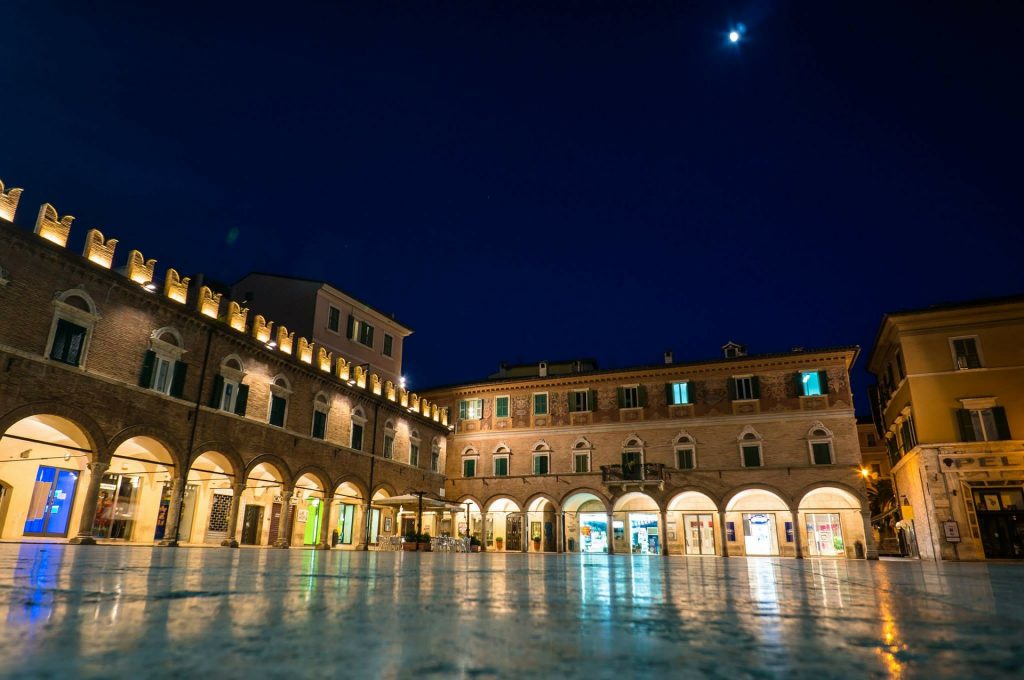
Ascoli Piceno is known as the city of one hundred towers, since in Medieval times it contained a huge number of towers, some of which have been preserved for visitors to see today. The Piazza del Popolo is one of the most beautiful squares in Italy. It’s second piazza – the Piazza Arringo – is less attractive by far but is home to the Pinacoteca, the town’s excellent art museum. Head to the museum to see a number of works dating from the 16th and 17th centuries which display Ascoli with its towers in tact to get a feel for how this beautiful city once looked. However, for those that prefer a more contemporary style of art, visit the Galleria d’Arte Contemporanea instead which boasts some superb pieces from the 20th and 21st centuries.
The centre of the town is lively and it’s definitely worth visiting in the evening when the piazzas fill with locals meeting up for a stroll or drinks. There are plenty of good shops to browse as well as several interesting churches.
Visit in July and August and you will be lucky enough to experience the Quintana, a Medieval jousting tournament. Earlier in the year, the residents also enjoy celebrating Mardi Gras to the full.
Cagli
A town in the province of Pesaro and Urbino, Cagli is dominated by its fortress – Rocca Torrione di Cagli. This is now home to a Centre for Contemporary Sculpture and houses a number of works by Francesco di Giorgio Martini. Cagli is a town that can boast a rich artistic heritage. Rafaello’s father – Giovanni Santi – and Gaetano Lapis are among a number of artists who worked here. A number of Lapis’ works can be found in the Cathedral in Caglia as well as works by Conca, Garzi and ‘Sassoferrato’. Also worth visiting in the town are a number of other religious buildings including the Church of San Domenico, the Church of Santa Maria della Misericordia and the Church of San Francesco.
Camerano
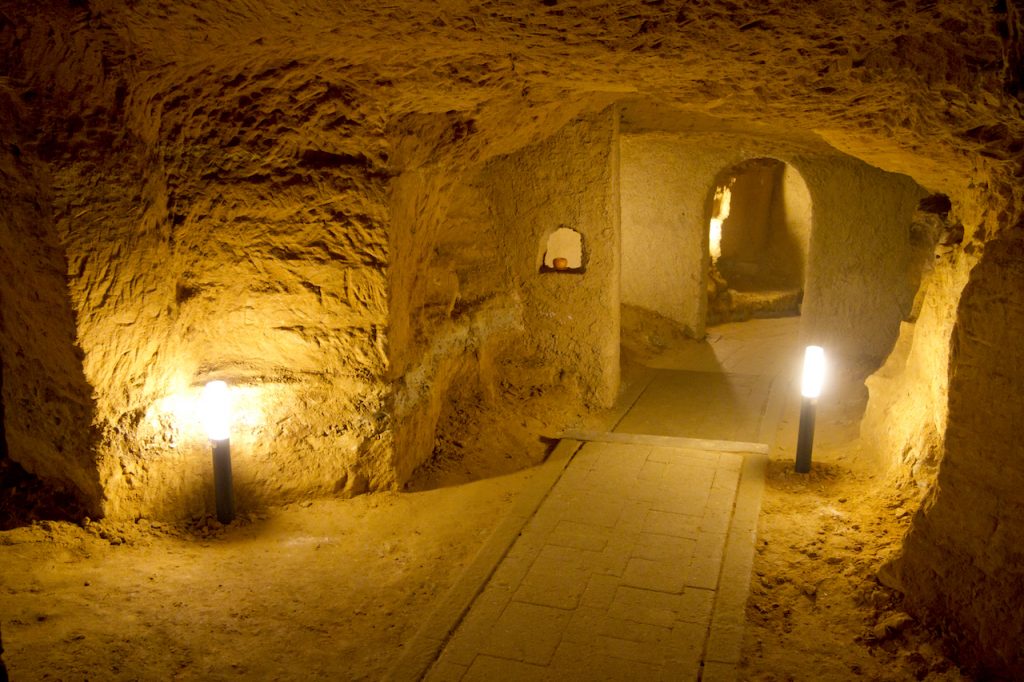
This town is more famous for what lies beneath the ground than what is above it. A network of tunnels and caves have been carved into the sandstone following the lines of the streets that sit above them, many of which are decorated with carvings. No one really knows how old these are or what their purpose is.
Camerino
Camerino is a hilltop university town most famous for its Borgia fortress, built by Valentino in 1502. It has a very pretty centro storico, whose centre is the main square – Piazza Cavour – around which stand many buildings of note, not least the Cathedral and Archbishop’s Palace. The square is also home to the Palazzo Ducale, once the residence of the Da Varanno family and today the seat of the University of Camerino. An internal porticoed courtyard boasts a balcony offering a breathtaking view of the Sibillini mountains and the botanical garden.
Try and time your visit to Camerino with the chance to enjoy a production at the Teatro Marchetti. This theatre was originally constructed in 1856 but has been recently restored and put back into use. The ceiling is decorated with scenes from Filippo Marchetti’s famous opera Ruy Blas.
Finally, don’t leave without visiting the Church of Seminario where visitors are treated to a host of stunning artworks.
Conero peninsula
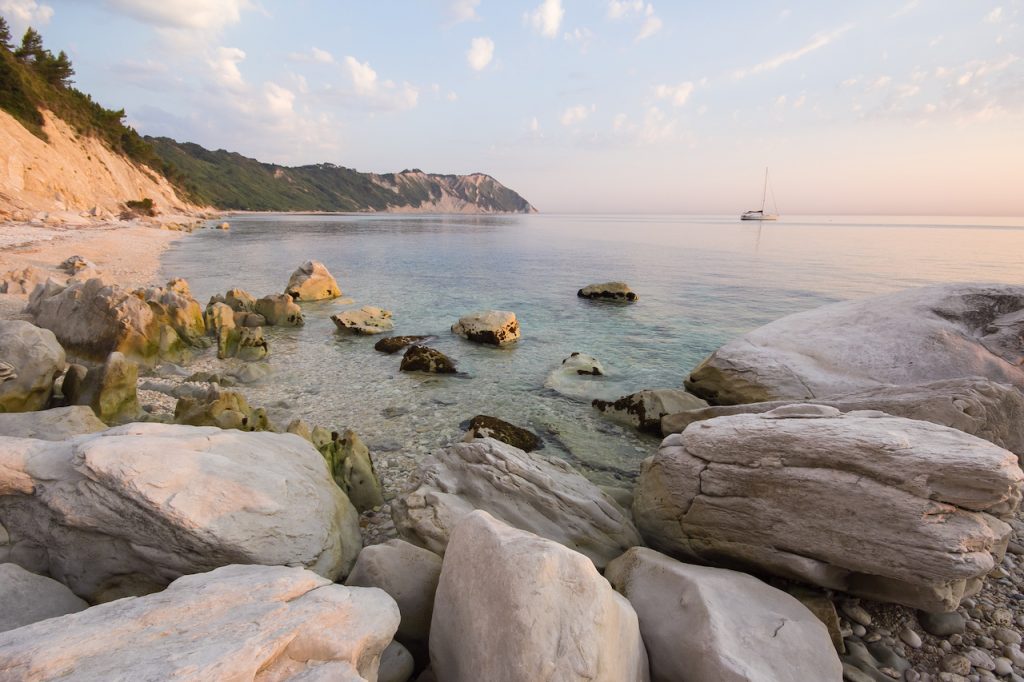
This is the name given to the stretch of coastline and 572 metre high ourcrop of Monte Condero that sits to the South East of Ancona. Often referred to as the Conero Riviera, it is now a protected nature reserve and also home to some of the most attractive coast and beaches anywhere in Marche. It’s the perfect destination for keen walkers, with 18 clearly signposted nature trails of varying levels of difficulty to enjoy within the park. Walkers will be treated to walks through vineyards and olive groves as well as through wheat, lavender and sunflower fields whilst enjoying some spectacular views over steep cliffs to the near isolated beaches below. It is home to a number of excellent beaches including Sirolo, Numana, Marcelli and Portonovo as well as home to a number of important archeological sites too.
Corinaldo
One of the ‘piu belli borghi d’Italia’ Corinaldo is a picturesque hilltop village in Marche. It is almost perfectly symmetrical, built in the shape of a heart hence its name which is derived from the Latin Cor in Altum (‘Heart on High’). Surrounded by 14th century walls (which visitors can walk all the way along) and divided in two by a long central stairway (Piaggia), it’s a picture-perfect village which incidentally also hosts an annual Halloween festival each October. This Witches’ Festival has been held since the beginning of the 21st century and has swiftly become one of the largest festivals in Le Marche. Set over three evenings, it includes plenty of opportunities to enjoy the local food as well as entertainment, craft markets, art shows, street performers and the election of Miss Witch. The village is also transformed into a spooky wonderland with torches and pumpkins.
If you can’t visit during the festival, then take the opportunity to marvel at some of Corinaldo’s other wonders including the Pozzo del Polenta (a well that supposedly spewed out polenta instead of water during the siege of the village keeping the villagers alive), the Church of Santa Maria Goretti, the 18th century Palazzo Comunale, the Civica Raccolta d’Arte Claudio Ridolfo (an old convent which now houses works by Ridolfo) as well as the beautiful little opera house – the Teatro Goldoni.
Fabriano
Fabriano is most famous for the manufacture of paper, a tradition that goes back to the 12th century. In the 18th century, the paper from Fabriano was chosen to be used by many countries for making bank notes because of its excellent quality and euro bank notes are still printed here today. Back in the 18th century, it was Pietro Miliani, an entrepreneur from Fabriano who persuaded the Italian authorities to use the paper from Fabriano for making bank notes. He set up his own company in 1782 and since then has become famous for ‘Fabriano’ sketch books which are now produced on an industrial scale. Visitors can learn more about this at the town’s Museo della Carta e della Filigrana, an interesting and informative museum that provides information on the way paper has been produced through the ages.
Fabriano has a wider tradition of industry and manufacturing, also home to an industry producing domestic appliances (it is the HQ of Indesit) as well as a thriving clothes and building material industry and food processing industry, producing salami.
The paper museum is not the only museum in Fabriano worth visiting. Also of note is the Museo dei Mestieri in Bicicletta, a small museum which covers the importance of the humble bicycle in Italian history and the use of the bike by everyone from bookseller to milk vendors.
And the town has a number of other landmarks worth visiting including the Cathedrale di San Venanzio, home to a number of Medieval frescoes. Some of the frescoes are by Allegretto Nuzi who was born and died in Nuzi and was a renowned Gothic style artist. The central square in Fabriano is the Piazza del Comune. Here you will find the Palazzo Comunale whose courtyard provides access to the Teatro Gentile, a delightful 19th century 600 seat theatre.
Falerone
A delightful village, Falerone may not be on the main tourist trail but it’s a lovely example of a typical Italian village where you almost feel you have stepped back in time. Life is a slower pace here. Visit the village during the ‘Contesa de la Nzegna’, an incredible Medieval re-enactment and procession with people dressed in period costume with ox-drawn carts, remembering the daily lives of their ancestors. And of course, it features plenty of opportunities to eat the local food!
Fano
Fano is a pretty coastal fishing town dating back to Roman times when it was founded by Julius Caesar in 49 BC. It has a pretty historic centre and the fishing port separates the two excellent beaches from one another – the Spiaggia Lido and the Spiaggia Sassonia – both of which have been awarded the famous Blue Flag status. Locals and visitors alike flock to these beaches in the Summer months. The town boasts some excellent restaurants, which not surprisingly specialize in fish. Make sure you try the famous fish soup (brodetta alla fanese) washed down with the unique fisherman’s coffee (moretta) which is a tasty blend of anise, rum and brandy.
Visitors will enter the city via the main entrance – the Arco d’Augusto. This was built in 9 AD by the Emperor Augustus from a mix of marble and sandstone. Head down the main street – the Via Arco d’Augusto – lined with shops and cafes. On the right hand side, you will pass the Cathedral of Santa Maria Assunta. This dates back to the 12th century but has undergone several modifications since then, in part due to destruction caused by both sea bombardment in WW1 and bombing in WWII. Also worth a visit in the town is the church of Santa Maria Nuova and the church of Santa Maria del Suffragio.
Another beautiful building, despite being without a roof, is the church of San Francesco, home to the tombs of Pandolfo III Malatesta on the right and his wife, Paola Bianca Malatesta on the left.
Head to the main square – the Piazza XX Settembre – where a bronze statue of the goddess Fortuna stands in the middle of a fountain. Also here is the the church of San Silvestro and the beautiful Gothic façade of the Palazzo del Podesta which was built for the city’s Medieval rulers and which is now in part the city’s opera house, the Teatro della Fortuna. This is a stunning theatre with rather an ugly clock tower since the original was destroyed in 1944.
Fano is also home to the oldest carnival in Italy. Larger than life, brightly coloured floats parade down the streets, with chocolates and sweets thrown to the thousands of spectactors.
Fermo
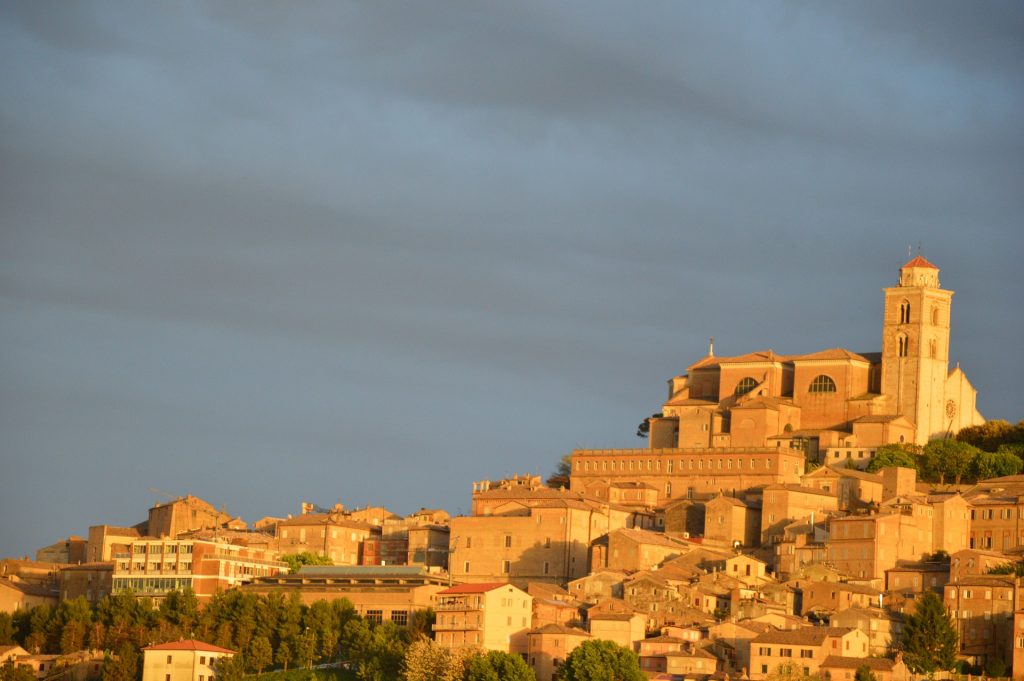
A pretty hilltop town, Fermo enjoys wonderful views of the surrounding countryside. Its centre is the Piazza del Popolo. Every Thursday morning throughout the year, you’ll find a lively market here whilst in the Summer months, you’ll also find that this is extended to include an antiques market every Thursday afternoon.
The town has a long and rich history. Evidence of Roman occupation can be seen in the remains of a Roman amphitheatre, whilst parts of the original town walls are still visible too. More can be discovered about its history in the Museo Archeologico, home to a number of Etruscan and Roman artefacts.
The most important building in the town is arguably the Duomo della Madonna. Built in 227 by Gorgio da Como, it’s a superb example of Gothic architecture. A rose window set above the main entrance dates back to 1348 whilst carvings around door depict the tree of life. The bell tower above is enormous and can be seen for miles around. However, also of note and worthy of a visit is the Church of San Francesco
However, probably our favourite attraction in Fermo is a guided tour of the underground Roman cisterns (Cisterne Romane). Holidaymakers can enjoy a guided tour of these enormous water storage cisterns built between 40 and 60 AD to supply the city with drinking water. It’s the perfect example of Roman engineering and ingenuity.
We can also highly recommend a visit to a performance at the Teatro dell’ Aquila, one of the largest theatres in Le Marche seating more than 1000 people.
Fiastra
Most people heading to Fiastra do so to take advantage of its nearby lake which is popular with both fishing and water sports enthusiasts alike, particularly in the Summer months when a dip in the water can be incredibly refreshing. The lake is actually artificial, created by the construction of a dam across the River Fiastrone. It is also possible to walk across this dam to enjoy the stunning views. Fiastrone Gorge is also a fantastic spot for walkers and cyclists and is a popular setting for horseback riding too.
Frasassi Caves
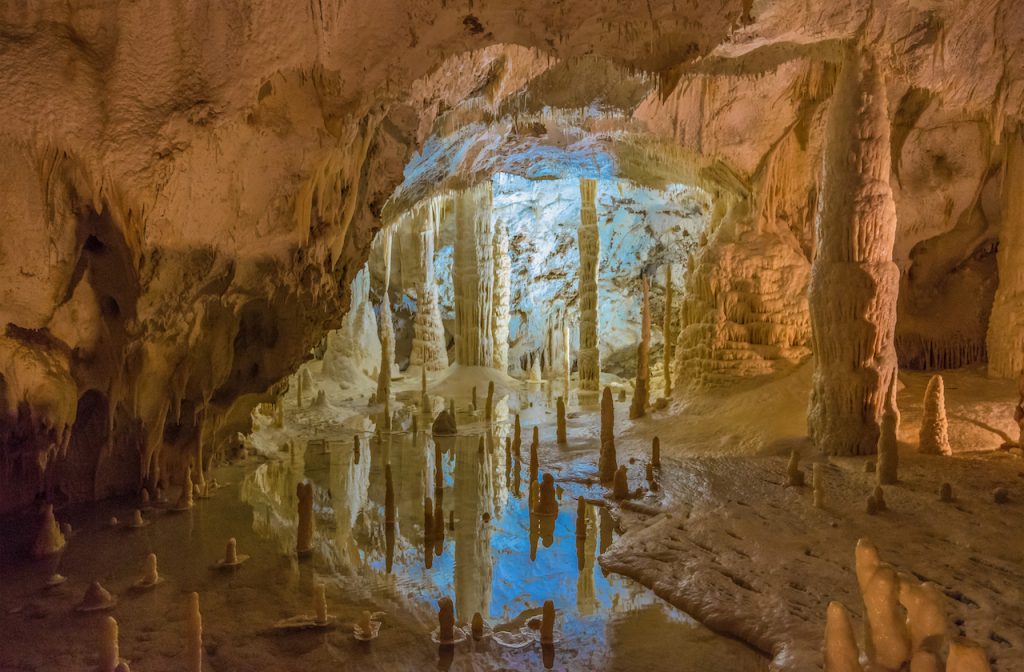
Arguably the most impressive of Marche’s sights actually lies below ground. The Frasassi Caves are an incredible spectacle. Over 1.4 million years old but only discovered as late as 1971, they were formed by a combination of sulphur and water which eroded the rock to create the cave system. So far 30km of this cave system has been explored and a walkway has been constructed through five of its caverns allowing visitors to enjoy the incredible spectacle. The biggest of these – the Ancona Abyss – is the largest cavern in Europe with vaulted ceilings 200 metres high. Other key stopping points on the guided tour include a crystallized lake and a cavern filled with stalagmites that look like candles. The most common tour will take just over an hour but there are a number of different routes you can choose to take, one of which does involve a 30 metre chasm decent for which harnesses are provided. The caves are always cool so even in the peak of the Summer, it is advisable to take layers that you can put on as you descend into the cave network.
Furlo Gorge
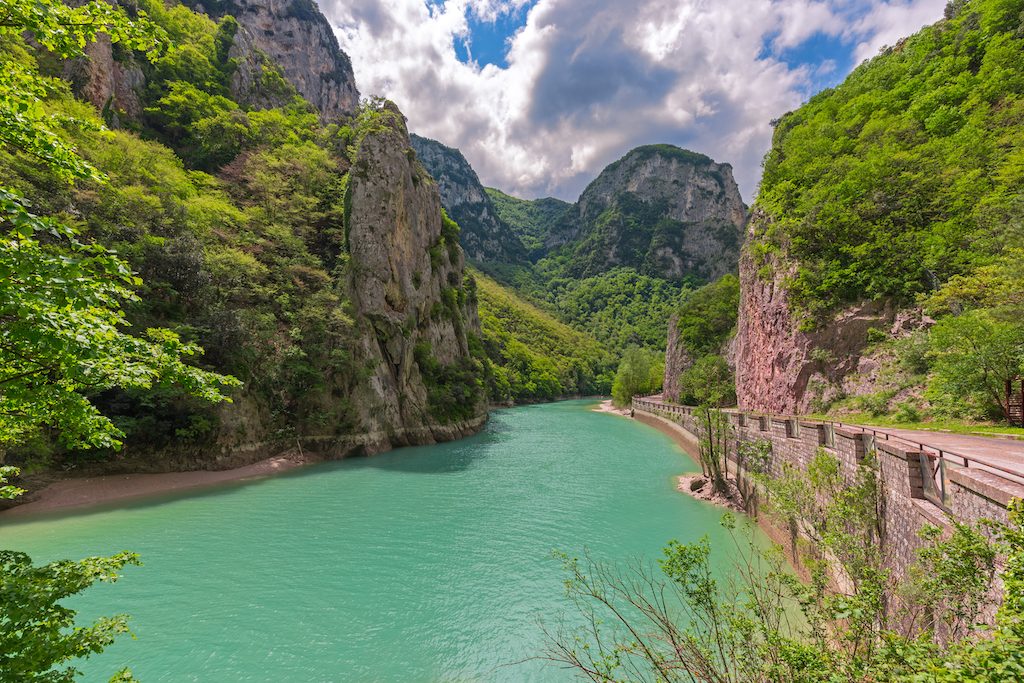
The Furlo gorge is a spectacular ravine, a visit to which is not to be missed. The River Candigliano cuts through the rocks of the Apennine mountains creating the most amazing spectacle. Those beady eyed amongst you will perhaps spot the enormous profile of Mussolini’s face which the dictator had cut into the rocks on the North side of the gorge, such a fan was he of the beauty spot. Partisans did their best to destroy the image but it can still be made out. It’s easiest to spot from the village of Furlo itself.
It’s the perfect spot for hikers and walkers too, with numerous pathways cut into the wooded slopes above the gorge. One such walk even allows visitors to sit and picnic on top of Mussolini’s broken nose!
Genga
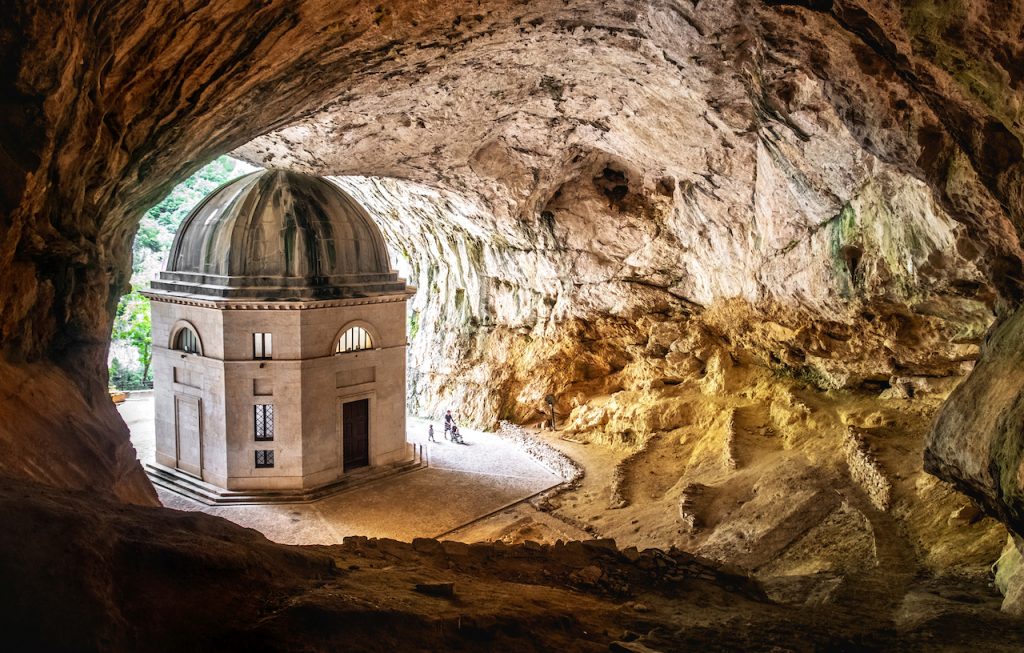
Genga is a tiny Medieval town set in the heart of the Rossa-Frasassi Park surrounded by wooded hills. It’s a quaint stopping place for an hour or two. Visitors can explore what it has to offer including the 11th century castle and its museum where you can view works by Antonio da Fabriano and Antonio Canova.
Genga is most famous at Christmas time, thanks to the living nativity that it holds in the Gortto del Santuario in the Frasassi Gorge which holds a small octagonal chapel built by Pope Leo XII.
Gradara
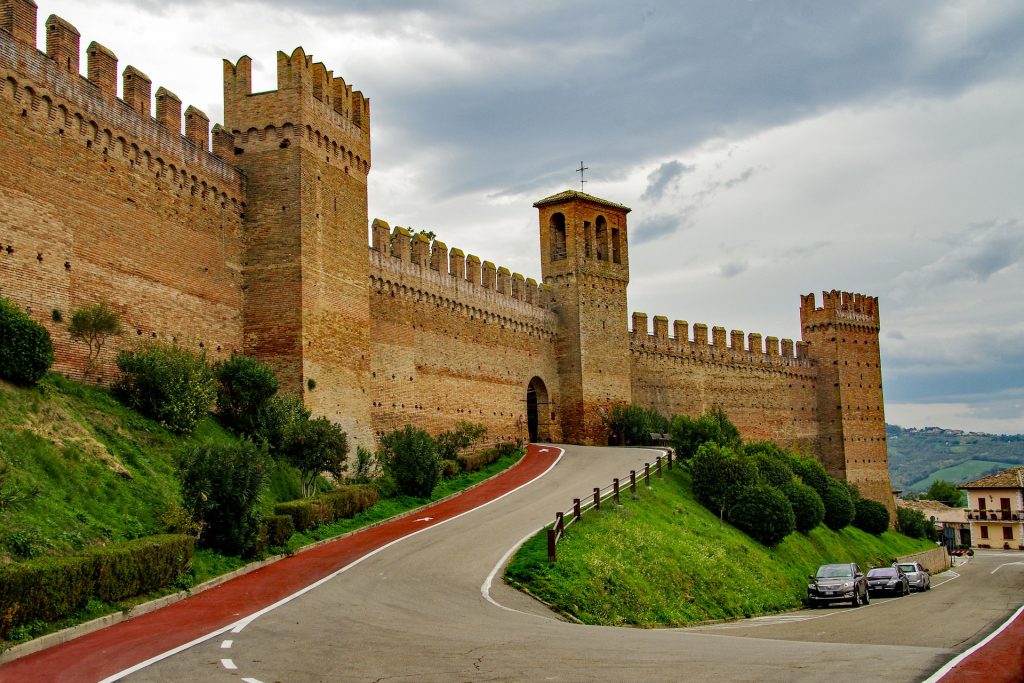
Gradara is a beautifully preserved Medieval village. It is also the setting of a tragic story to rival that of Romeo and Juliet and which has inspired many a writer over the centuries including Byron and Dante. So the story goes, Francesca da Polenta was married bv proxy to Giancotto, an unpleasant and ugly man. He locked her up in the fortress at Gradara when he was sent to Pesaro as governor. Here, his brother, the handsome Paolo, kept her company and the two fell in love. One night, Giancotto unexpectedly returned and caught the two lovers, stabbing them both to death. Nowadays, visitors can still see the setting for these events thanks to a wealthy engineer. The castle was almost completely destroyed in an earthquake in 1916 but was subsequently bought as a private home in 1920 by this engineer who then devoted his life to its restoration. Upon the death of his widow who continued to live there after his death, it was donated to the Italian government. Visit at night when there is a full moon and people will tell you that it is sometimes possible to see the ghost of Francesca da Polenta walking along the castle’s battlements. As well as visiting the castle, a visit to the Church of San Giovanni Battista is also recommended, home to a 15th century wooden crucifix.
Grottammare
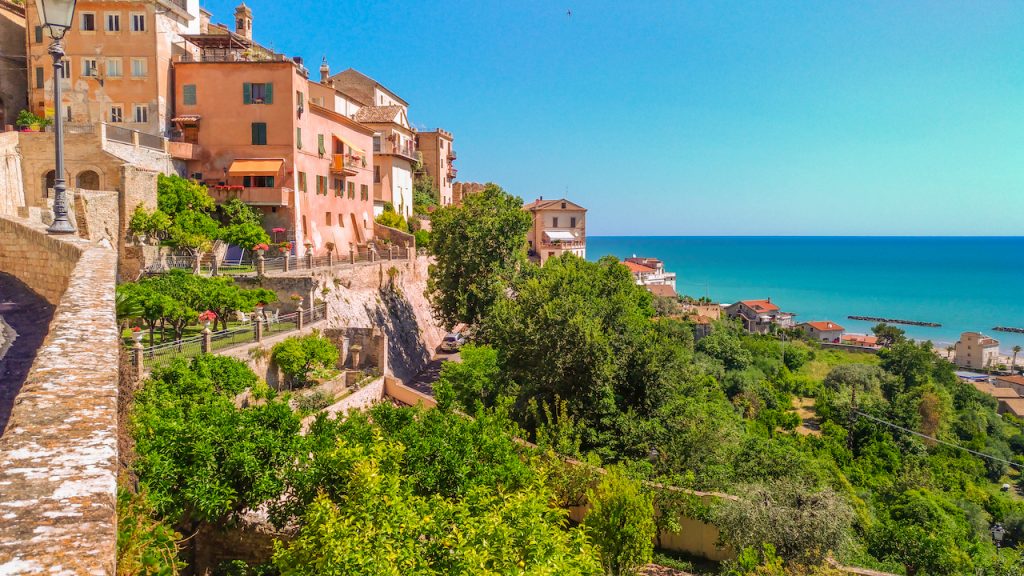
Grottamare is a popular seaside resort. It’s also the setting for the annual Festival of Liszt (since the composer sometimes spent his holidays here including a 6 week stay with Count Fenili in 1868) held in the last two weeks of August and which brings together pianists from all over the world.
Along the sea front, you’ll find numerous Art Nouveau style villas, one of which is home to the Museo dell’ Illustrazione Comica, a collection of comic cartoons. Also worthy of a visit is the Piazza Peretti, home to the Teatro dell’ Arancio (so-named because of the large olive tree that once grew in the town square) and the nearby Church of Sant’ Agostino (which only has half a bell tower as the other half was demolished as a punishment for the congregation supporting the teachings of Martin Luther) and the Church of Santa Lucia which has a beautiful organ.
Loreto
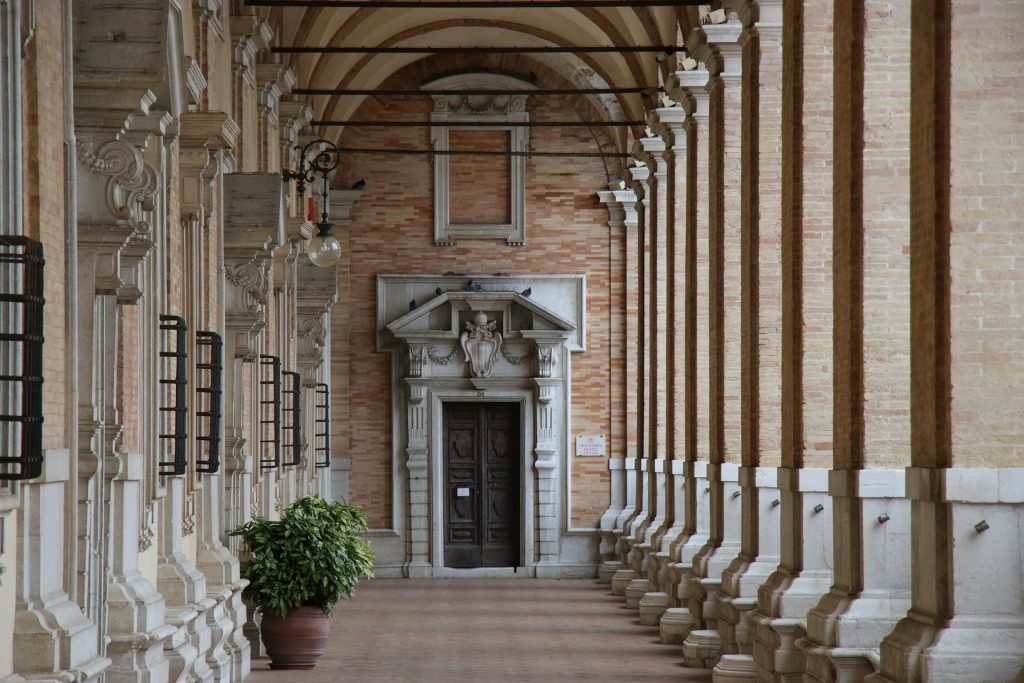
Loreto is a popular pilgrimage site in Europe, second in visitor numbers only to Lourdes. The Basilica della Santa Casa is an impressive spectacle but most come to visit what it holds inside – the simple house of Mary and Joseph which is believed to have been brought from Nazareth in the 1290s. Some storytellers relay how the house was brought there by angels. Others say that it was brought by crusaders.
Macerata
Macerata is home to one of the world’s oldest universities founded in 1290 and its student population certainly gives the city a lively feel. Enjoying amazing views over the Marche countryside, it’s also incredibly beautiful with many important historical buildings including the Palazzo del Comune, the Palazzo della Prefettura, the Church of San Paolo, the Laura Rossi theatre and the Loggia dei Mercanti, all of which overlook the central Piazza della Liberta. Like many towns and cities in Le Marche, its roots date back to Roman times and visitors can also explore the Helvia Recina Roman theatre which dates back to the 2nd century AD.
There is plenty to delight the art lovers and historians amongst you. The Palazzo Ricci, for example, is home to a superb 20th century art gallery whilst the Mozzi-Borghetti public library contains many incredibly rare and ancient manuscripts. Giacomo Leopardi, one of Italy’s greatest poets, was born here.
It’s also a fantastic spot for music lovers. The Arena Sferisterio in the heart of the city plays host to an annual Opera Festival.
Mondavio
Sat upon a hill overlooking the Cesano valet, Mondavio is one of the best-preserved Medieval towns in Le Marche enclosed by ancient Medieval walls and dominated by a formidable 15th century castle – the Rocca – which remains in tact today, complete with massive towers, drawbridge and rooftop walkways. It is also home to a museum which educates visitors on military history with displays of costumes and weapons from the 15th to 18th centuries.
Mondavio also offers an opportunity to enjoy some considerable artworks in both the Palazzo Municipale and the Civic Museum and it boasts a delightful little opera house and theatre – the Teatro Apollo – which is still in use today.
Head to the town in August and you can join in the Renaissance style banquet and festivities. There are more festivities with food and dancing to coincide with the Autumn grape harvest and then again in November.
Montelparo
Montelparo is a small, picturesque town founded in the 8th century by the Lombard chieftan Eliasdoe. Nowadays it is home to a rather unique museum – Mostra degli Artigiani su Ruote – where a variety of antique bicycles, carts and trolleys are on display. There are also some other buildings worthy of note, among them the Sant’ Agostino monastery, the Torre Civica and the church of San Gregorio Magno.
Numana
Numana is a fishing village at the Southern trip of the Parco del Canero, characterized by charming colourful houses.
Offida
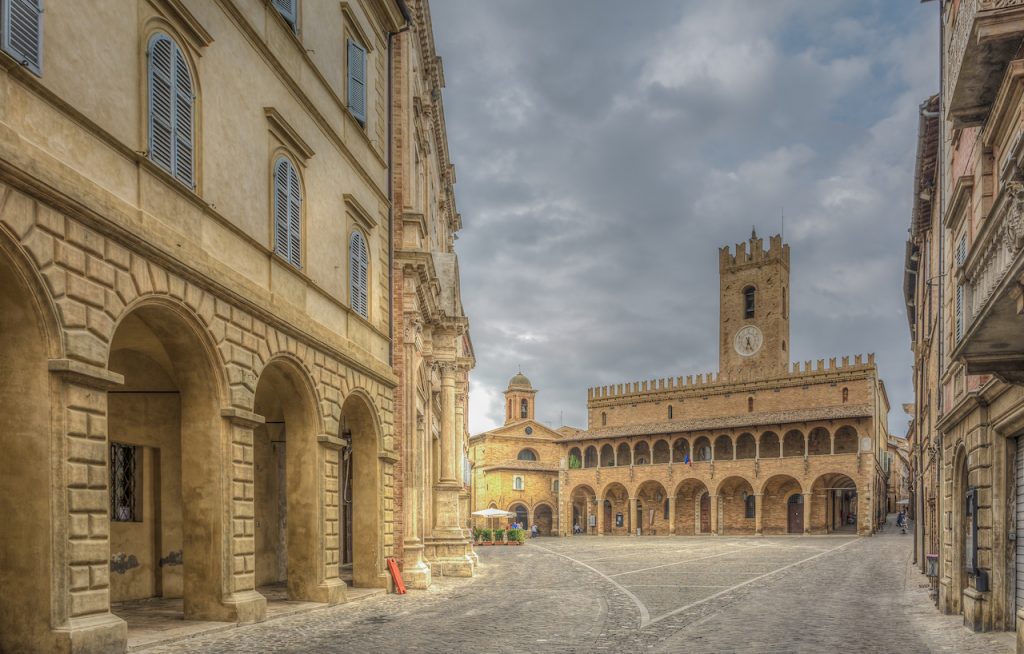
Offida is famous for its production of lace which has been produced here since the 1400s. The age-old lace making tradition using bobbins has been passed from generation to generation and you can still see both men and women sitting in the street or in their homes moving the tiny bobbins to create their works of art.
Lace is not the only thing that comes out of Offida though. The town is also famous for its wine production using grapes found only in this region including Pecorino, Passerina and Rossa Piceno.
And Offida is also famous for its annual carnival – Bove Finto – that starts on 17 January and ends on Ash Wednesday. Animal lovers will be pleased to hear that no actual bulls are involve but instead a fake (finto) wooden bull. This is carried on the shoulders of the crowd until it is finally ‘killed’ and its horns are lifted to the columns of the town hall.
The most important building within Offida’s ancient brick walls is certainly the 14th century Gothic Church of Santa Maria della Rocca, the resting place of St Leonard. It’s a beautiful pale brick building with a simple interior. Built dramatically into the rock, it contains fragments of 14th century frescoes.
Osimo
Osimo is a hilltop town, enjoying tremendous views across to the Conero coast and over rolling hills to the Apennine mountains. Its narrow streets and alleyways and beautiful piazzas are lined with some incredible Renaissance palazzi and other beautiful buildings, not least the Cathedral of San Leopardo and the Teatro Nuova Fenice. The Palazzo Municipale is home to 12 headless statues found on the site of the Roman forum, testament to the town’s long history.
We can highly recommend a stroll around the Giardini di Piazza Nuova, a lovely garden with excellent views.
Pesaro
Pesaro is a popular seaside resort, with an attractive historic centre, high end shopping and good beach. It is also the birthplace of Italian composer, Rossini, composer of the Barber of Seville. Visitors can head to Casa Rossini to see where the great man once lived. Nowadays the house contains a collection of prints of Rossini and his contemporaries, all with a backdrop of his music which is played on a constant loop. To be honest, there isn’t a great deal here to see but if you’re a music lover, then it’s worth a trip.
Also worth a visit is the Musei Civici (the art and ceramics museums), the Museo Oliveriano (the archeological museum) and the Cathedral. Rather than looking up in this building, take the time to look down below your feet. After all, arguably the most impressive part of the building are the mosaics found underneath the floor and which date back to the 4th and 6th centuries. Glass panels allow visitors to look down at the fragments of what was probably once the floor of an early Christian basilica.
This rural hamlet enjoys some of the best views in central Italy. Until a few years ago, it was nothing but a ruined hamlet but it was completely restored and is now home to a hotel, restaurant, art complex and open-air gallery. The whole place has essentially become a contemporary sculpture park.
Pietrarubbia
Home to a ruined castle, which is quite a spectacle at sunset since the mountainside takes on a reddish tinge thanks to the sun, we recommend a trip to Pietarubbia simply to enjoy the views from the town across the rolling hills to San Leo and San Marino. This rural hamlet enjoys some of the best views in central Italy. Until a few years ago, it was nothing but a ruined hamlet but it was completely restored and is now home to a hotel, restaurant, art complex and open-air gallery. The whole place has essentially become a contemporary sculpture park.
Portonovo
Portonovo forms the Northernmost centre of the Canero National Park. There are a smattering of shops here but if you’re a keen walker, there are some lovely walking routes that start out here including an easy 90 minute walk around the natural saltwater lake of Lago Grande. It also has a stunning white pebbled beach overlooked by a former Napoleonic fort (now a hotel) once used to dissuade British ships. There is also an 18th century watchtower known as either the Torre de Bosis or Torre Clementina.
Porto Recanati
Porto Recanati is a fishing harbour. Not surprisingly, the restaurants here focus on fish dishes, with the local speciality being a fish soup enriched with locally grown wild saffron. The town is dominated by a 13th century castle, originally built to protect the area from attacks by pirates but which is now home to the Pinacoteca Comunale Attilio Moroni containing numerous works of art. A lovely 4 km walk starts from the town along the old pilgrim route to Loreta. It boasts a long Blue Flag shingle beach.
Recanati
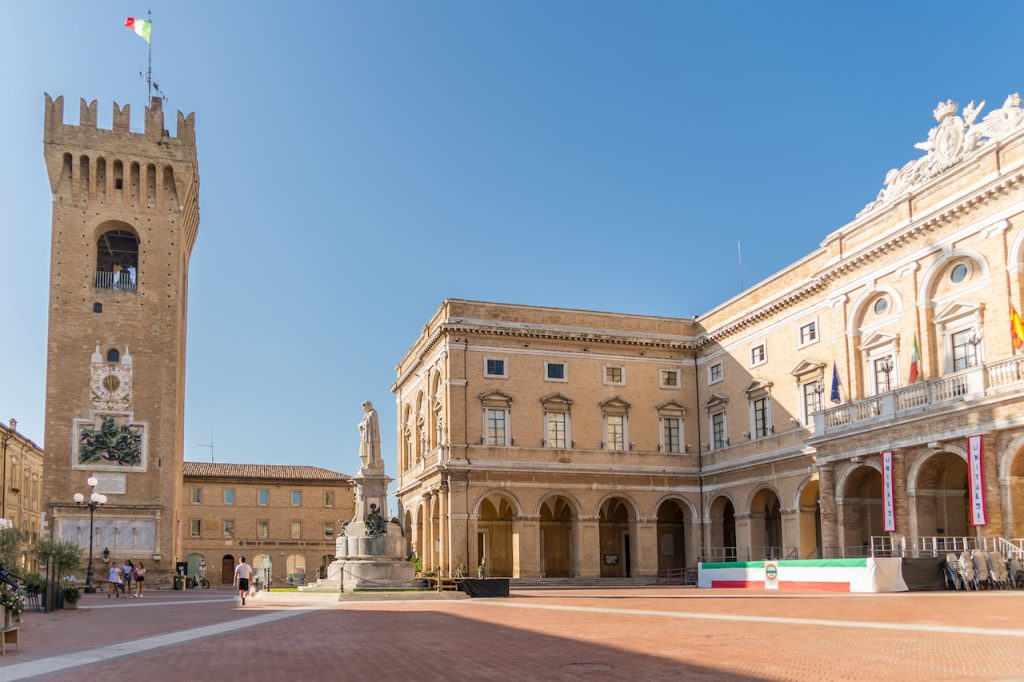
Affectionately known as ‘the city of poetry’ since it was the birthplace of Giacomo Leopardi, Recanti is a very pretty place enjoying lovely views of the surrounding countryside from its elevated position. You’ll find plenty of references to Leopardi within the city, the most striking of which is probably the bronze monument in the central Piazza Leopardi which is overlooked by the 36 metre high, 12th century tower – the Torre del Borgo. You can also visit the home where the poet lived – Casa Leopardi where you can view numerous books and manuscripts in his library. Certainly, Leopardi’s most famous work is ‘The Infinite’ and the Summit of Monte Tabor which sits behind the must-see Palazzo Leopardi is now more commonly called Colle dell’ Infinito after his work. It’s a pleasant walk.
However, Leopardi was not the Italian to be born here. The opera composer, Giuseppe Persiani, was also born here as was Baniamino Gigli, an opera tenor whose life is marked in the city with a museum dedicated to him. The unsurprisingly named Museo Gigli has a reconstruction of the famous tenor’s dressing room along with many of his costumes. For those looking to enjoy some opera these days, head to the city’s opera house – Teatro Persiani.
Another museum worth visiting in the city is the Villa Corredi Museum, home to four paintings by Lorenzo Lotto, the Venetian born Renaissance painter who came to live and work in Le Marche. And during your visit, also take time to explore the 14th century cathedral. From here, you can also access an old papal prison where 32 witches were once imprisoned and subsequently burnt at the stake, as well as the rather impressive collection of artworks in the Museo Diocescano. If you’re a fan of more contemporary art, then head to the Museo d’Arte Contemporanea instead, housed in the convent of Sant’ Agostino.
San Benedetto del Tronto
A popular seaside resort and fishing port, San Benedetto del Tronto has enjoyed Blue Flag beach status since 1998. Its long sandy beaches are flanked by an equally long promenade lined with over 7000 trees including palm trees, pine and oleanders. It’s the perfect place for a bike ride or walk. Take note of some of the artworks here too – artists from all over the world have come here to carve into the large rocks that line the promenade. One of the most eye catching sculptures on the sea front though is arguably not these but the eye catching monument to Jonathan Livingstone Seagull, a fable about a seagull trying to learn about life and flying and written by Richard Bach.
Visitors should try and arrive early to experience the hustle and bustle of the fish market. Next door to this is the Museo Ittico Augusto Capriotti, a collection of over 6000 species of fish, all found in the Adriatic Sea. And yet more information on the rich fishing industry that the town is famous for can be found in the nearby Museo della Pesca e della Civilta Marinara which looks into the history of fishing and the people involved.
Not everything revolves around fishing here though. San Benedetto del Tronto also hosts a Challenger Tour tennis tournament every July that over the years has attracted some of the world’s top tennis players to Le Marche.
San Ginesio
San Ginesio deserves its place on the list of the ‘piu belli borgi d’Italia,’ not just for its delightful town but also for the amazing views it enjoys over the surrounding Gran Sasso d’Italia park and the Sibylline Mountains.
Enter the town via the 13th century gate – Porta Picena – and make your way from here, past the Ospedale di San Paolo (a pilgrim hospital dating back to the 13th century) to the central square – Piazza Gentili. Here you will find a bronze statue of Alberico Gentili, after who the square is named. He was a professor at Oxford University and is widely recognized as one of the founding fathers of the modern principles of international law. You will also find the Neoclassical opera house – Teatro Giacomo Leopardi – here along with the Collegiata, a Romanesque – Gothic church.
There are many other churches within the town, the most notable of which is the former church of San Sebastiano which these days houses a collection of Renaissance artworks including paintings by Simone de Magistris, Nicola da Siena and Vincenzo Pagani.
San Leo
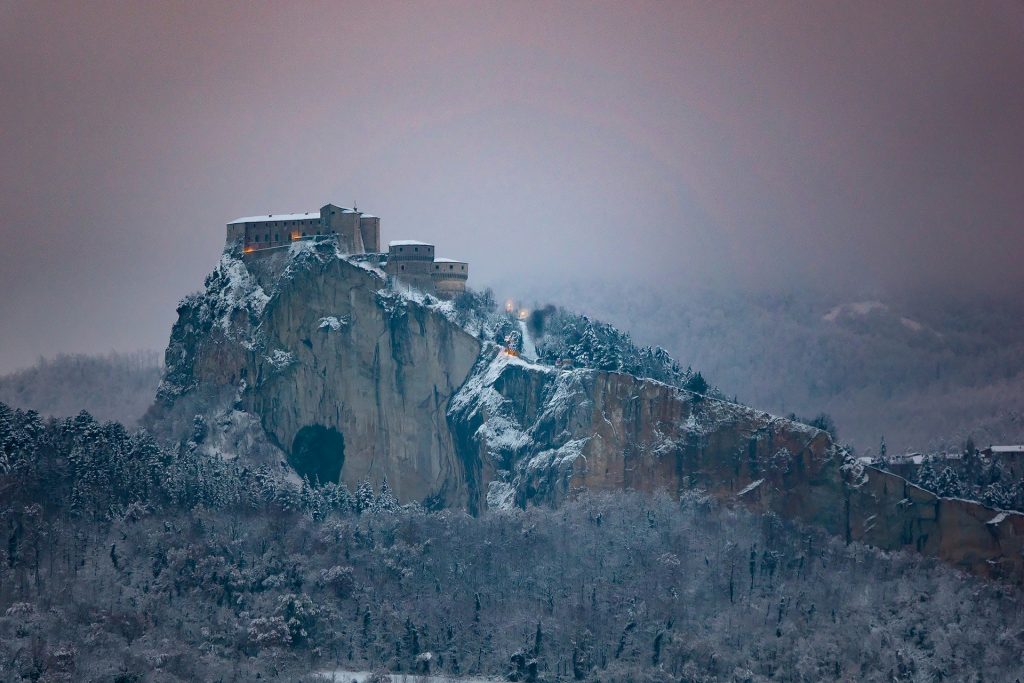
Situated in the North of the Marche region, San Leo is a tiny town that sits on top of limestone cliffs and which boasts a wonderful example of a Renaissance castle. In fact, the origins of the castle date much further back than Renaissance times, perhaps even as far back as Roman times. There is no doubt that its origins certainly date back to the sixth century but most of the design you see today is the work of the Renaissance artist, Francesco di Giorgio Martini, who improved the castle’s defences on behalf of Federico da Montefeltro who had captured the building in 1441. Today a tour of La Fortezza includes a visit to a weapon and armour museum, a trip to the torture chamber and a visit to the various cells where prisoners would have spent their final days when the castle was used as a prison between the 17th and 20th centuries. The castle (Fortezza) can be reached on foot in about 5 minutes from the centre of the village. Alternatively, there is a car park just below the castle walls. Head to the castle to enjoy views of the tiny republic of San Marino in the distance.
Also in San Leo is the Museo d’Arte Sacra (The Museum of Sacred Art), the Duomo di San Leone at the top of the town, and the Torre Campanaria.
San Severino Marche
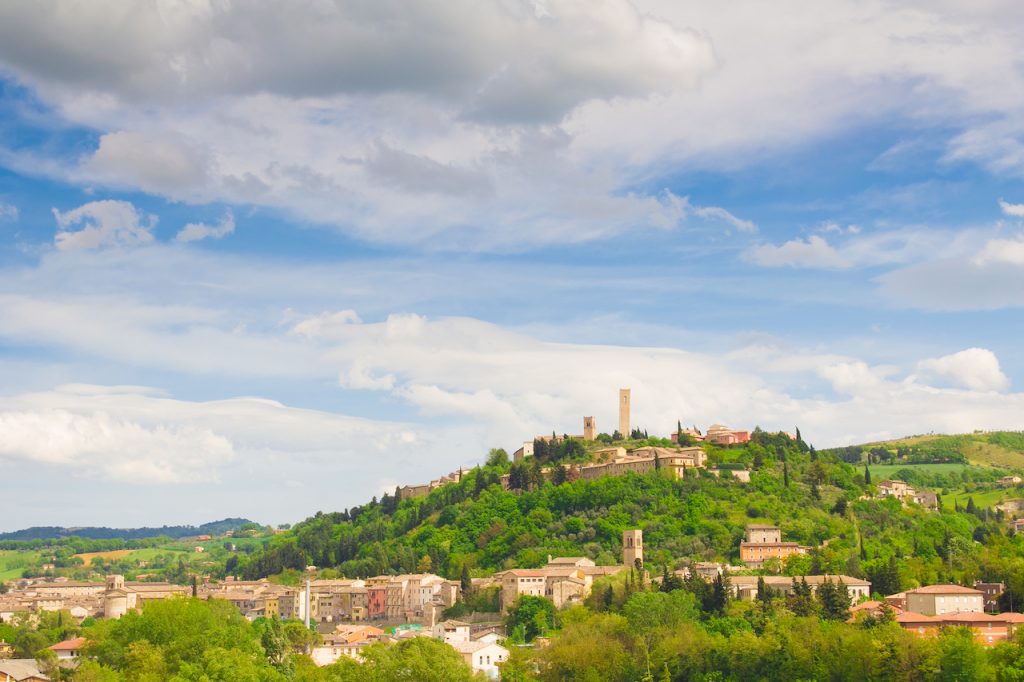
This attractive town, set in the rolling hills of Marche, is home to a number of interesting monuments, churches and palaces. The town is split into two quite distinct parts though –Castello high on the hill and Borgo down below. As the story goes, the former was founded in the 6th century. Following the destruction of the town by Toleto and the subsequent death of Bishop Severinus, the townspeople decided to let fate play its part in where the new town would be located. Severinus’ body was put on the back of an ox cart and wherever the cart stopped was where the new town would be. It stopped on Mount Montenera and so this is where the city was built.
A good starting point for any visit though is down in the lower area at the Piazza del Popolo, lined with shops and cafes and usually bustling with people. It’s also where you will find the Gallery of Modern Art and a number of churches of note. These include the church of San Lorenzo in Doliolo and the 14th church of Santa Maria della Misericordia where you can find works by Lorenzo Salimbeni. Lorenzo and his brother were both born in San Saverino Marche in the late 14th century and were both superb International Gothic style artists although very little is known about their lives even today. More of their work can be seen at the Pinacoteca Tacchi Venturi.
Up on the hill above the Borgo is Castello where you will find the slightly leaning, highest clock tower of the Le Marche region standing at 40 metres tall. It can also lay claim to being the first tower in Marche to have a clock installed on it back in the 14th century. Also in this area is the Duomo Vecchio whose roots go back to the 10th century but which has seen numerous transformations over the years. And finally, you will find the Museo Archeologico Giuseppe Moretti here, displaying artefacts dating from pre-history through to the Roman and Picene civilisations.
Senigallia
Senigallia is another coastal town in Marche boasting fantastic white sandy beaches stretching over 1.3 kilometres, affectionately known as its ‘spiaggia di velluto’ (velvet beach). Yet there is plenty more to see in the town too.
Whilst at the shore, visit the Rotonda a Mare, Senigallia’s 1930s pier with circular pavilion at its far end. Head down here first thing in the morning to enjoy watching the sun rise or last thing in the day to enjoy the sun setting. The rotunda is a good example of Fascist architecture following damage sustained to the city by an earthquake in 1930.
The town dates back far beyond the 1930s though with roots in pre Roman times and there is plenty of age to see in its historic centre. In the heart of the city in the Piazza del Duca, you will find the Rocca Roveresca, a massive castle which, over the years, has served not only to defend the city and as the home of the Della Rovere (Senigallia’s ruling family during the Renaissance period) but also as a place to train soldiers, as a prison, a hospital and orphanage. These days it’s used for exhibitions. Also in the piazza is the 16th century palace of the same name – Palazzo del Duca – and the Palazzetto Baviera. Head inside for a tour to see the incredible stucco work by Brandani that adorn the ceilings, drawing inspiration from the Iliad, the Book of Genesis and the Labours of Hercules.
Other noteworthy buildings worth seeing include the opera house (Teatro la Fenice ), the Duomo located in Piazza Garibaldi and the Palzzo Mastai, birthplace of Giovanni Maria Mastai Ferretti who went on to become Pope Pius IX.
Senigallia is also where you will find one of our favourite Marche festivals – the Summer Jamboree – when the town heads back in time to the 1940s and 1950s. People will wander through the streets in authentic clothing from the era for the duration of the 2 week festival which is dedicated to American culture and music from those two decades including swing, rock n roll and lindy hop. There are a multitude of concerts on offer as well as dance classes, vintage market stalls and of course plenty of food!
Whatever time of year you visit, try and come when the market is running. Held in the Foro Annomario a daily food market is held here as well as a more general weekly market every Thursday. Just along from here is the Portici Ercolani. This sequence of covered porticos were built in the mid 18th century for the trade fair. These were meant to be mirrored on the opposite side of the river bank but the project was never completed due to lack of funding.
Sirolo
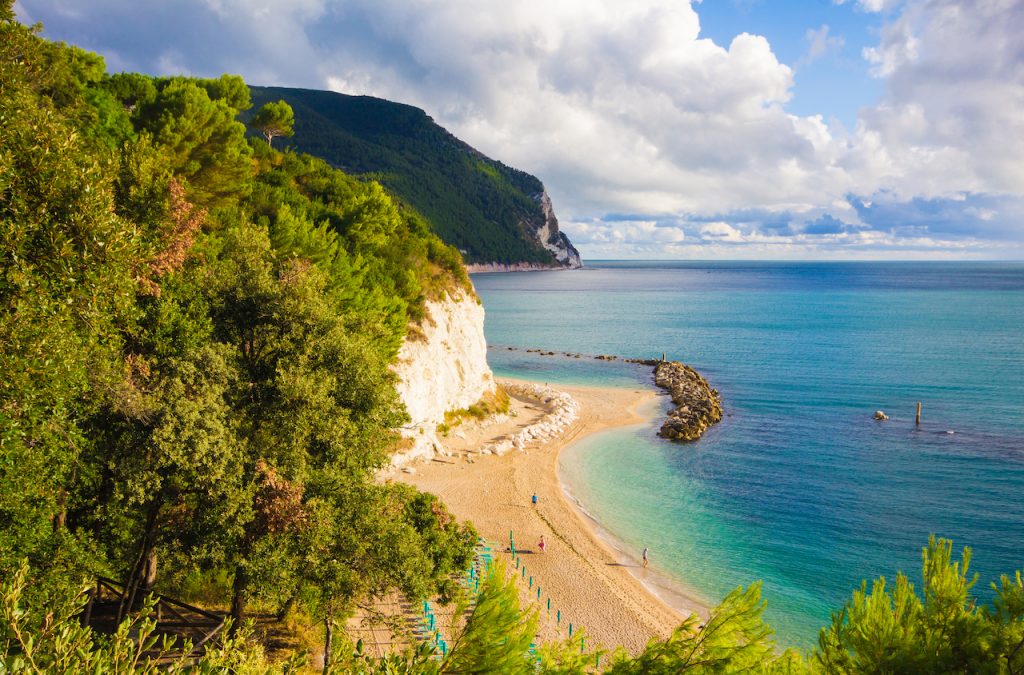
Perched on top of the cliff, Sirolo is often called ‘the most beautiful village of the Adriatic’ with pretty pastel coloured painted terraced houses lining its traffic-free streets. Certainly, it can boast one of the most beautiful beaches, accessed from the cliff top by a series of steep steps and pathways as well as via a shuttle bus from the main piazza (Piazza Vittorio Veneto) during the peak Summer months.
Tolentino
Tolentino has a rich history. It is home to the Castello della Rancia where, in 1815, the first battle for Italian Independence was fought. Visitors can explore the castle which also contains an interesting archaeological museum. Artefacts include objects from the Neolithic, Palaeolithic, Roman and Etuscan eras as well as from later Medieval times. Other interesting museums worth a visit include the Ceramics Museum, the Sanctuary museum and the Museo della Caricatura Luigi Mari. With a bias towards humour, the latter contains thousands of drawings, painting and puppets dating from the Stone Age to the present day as well as numerous comics and newspapers.
A good starting point for any visit is in the main square – the Piazza Liberta – an elegant area with a 16th century clock tower. Also noteworthy in the town is the Basilica di San Nicola, which originated in the 13th century but has been extensively modified since with a Baroque style façade dating from the 17th and 18th century. Inside, the highlight is the ‘Capallone of St Nicholas’ in which the walls and ceiling are entirely covered with a series of magnificent frescoes by Pietro da Rimini and his collaborators.
Treia
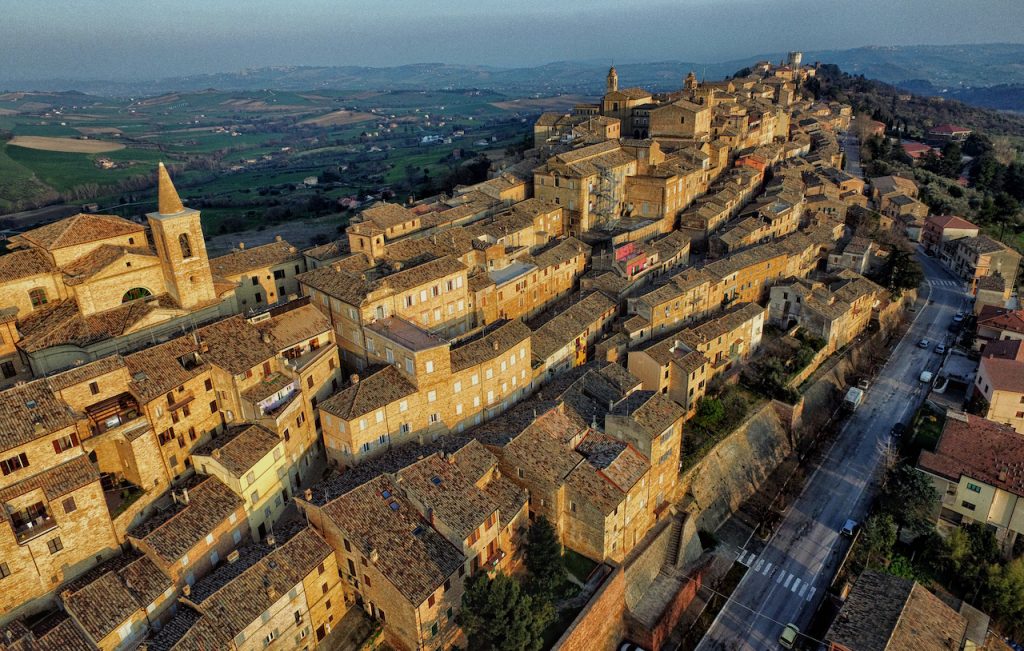
A beautiful ancient hill top village with a stunning square and wonderful views over fields, rolling hills and farmland to the Appenine mountains, Treia is worthy of a stop. It features in the list of ‘borghi piu belli d’Italia’ and it’s easy to see why. Buildings of interest include the cathedral, 17th century town hall and the Museo ~Civico Archeologico – containing both ancient Egyptian and Roman artefacts.
Head to the town during the Disfada bi Bracciole, a Medieval ball game played between the village’s four neighbourhoods once a year.
Urbania
Unfortunately, Urbania sustained a lot of damage due to bombing raids in 1944 during WWII however the old centre was sympathetically rebuilt and it remains an attractive town today. One of the main piazzas is the Piazza san Cristoforo where the famous opera house – Teatro Bramante – sits opposite the 17th century Palazzo Brancaleoni Materozzi. Another main square is the Piazza Liberta, near which you will find the convent and church of San Francesco and the adjacent Chiesa dei Morti (Church of the Dead). It’s perhaps not for the squeamish, containing a rather macabre collection of 18 mummies displayed in glass cases. In 1804, these were found buried in front of the church but mysteriously preserved due to a kind of mould when Napoleon ordered all the corpses in the city to be moved to more hygenic out-of-town cemeteries.
A visit to the town would also not be complete without seeing the Palazzo Ducale, inside which is the Museo Civico which houses a rich collection of artwork.
The town is also famous for its ceramic production and the painted earthenware known as majolica. You will find a number of shops and workshops in the town where you can learn more about its production or purchase a souvenir to take home with you.
Urbino
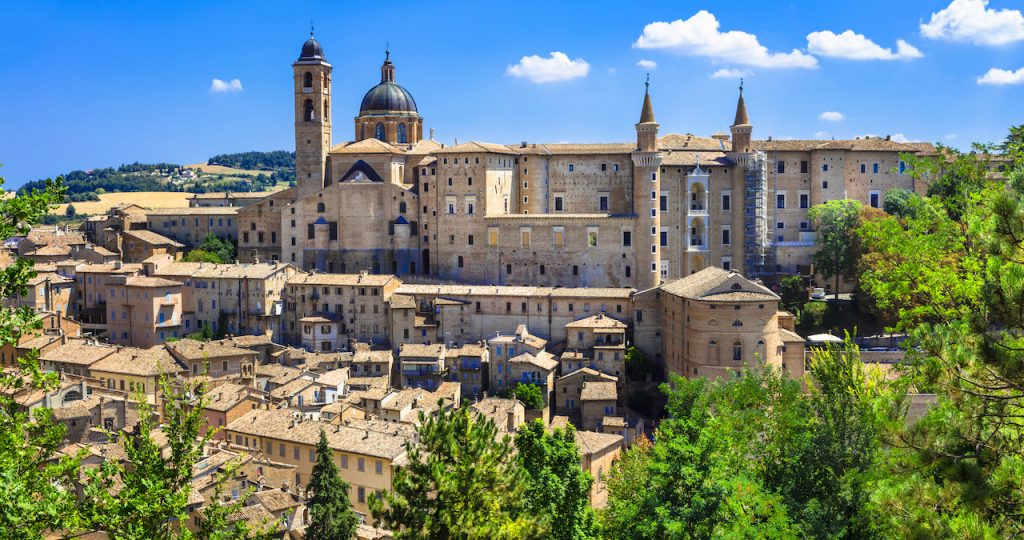
Urbino was one of the main centres of the Italian Renaissance and today is still viewed by many as an ‘ideal city’, with a perfectly preserved historic centre. Its history actually dates back many centuries before the Renaissance, certainly to the Roman period but little remains of its earlier past due to wars between the Goths and Byzantines in the 12th and 12th centuries which destroyed much of Urbino. However, glimpses of its Roman past do remain. For example, during repairs to the oldest church in Urbino – San Sergio – traces of a Roman swimming pool came to light, whilst in 1943, the remains of a Roman theatre were discovered on the Via San Domenico.
Urbino owes its current status to the Montefeltro family who oversaw its rebuilding. Federico da Montefeltro was the most important member of the family, summoning to his court numerous influential artists and writers, including Piero della Francesca and Joos Van Ghent.
If coming by car, we would definitely recommend parking in the largest parking area – the Borgo Mercatale. From here, you can easy visit all the main attractions on foot. However, there is another good parking area on the opposite side of town near the Porta San Bartolo. During peak season, make sure to arrive early. Car parks do fill up quickly as tourists flock to explore the city.
Those attractions not to be missed include the Palazzo Ducale which nowadays is home to Urbino’s main museums. On the ground floor you will find the Museo Archeologico Urbinate. The second floor of the palace is where you will find the Museo della Ceramica (Ceramics museum). However, it is nestled in between these floors that you will discover one most important art galleries in Italy – the Galleria Nazionale delle Marche – where visitors can view works by Piero della Francesca, Titian, Raphael, Uccello and others.
In fact, Urbino was actually home to Raphael. The great artist was born here on 28 March 1483, son of a well-known painter, Giovanni Santi, who died when Raphael was just 11 years old. It’s perhaps not surprising that there is a bronze sculpture honouring the great artist in the Viale Buozzi. It’s also possible to visit Raphael’s birthplace – Casa Natale di Raffaello – which is situated just up the hill from the Piazza Duca Federico and where many of his early works are displayed as well as reproductions of his most famous paintings.
Next to the Palazzo Ducale is the Duomo and San Domenico, again both worth a visit. The former replaced the cathedral built by Federico Montefeltro, destroyed as it was by an earthquake in 1789.
Nowadays, Urbino is host to many important festivals and it is worth trying to coincide your visit to partake in one of these. The Urbino Antiquaria is an antique market held on the fourth Sunday of each month, whilst La Festa del Duca is held on the third Sunday of August. This festival celebrates the history of the city and includes a jousting tournament. Residents will dress up in traditional costumes and those that have the chance to see it will be treated to a glimpse of Italian tradition. Finally, in the first week of September, there is a very different festival – the Festa dell’ Aquilone – where kites are flown from the Cesane hills.
Before heading away from Urbino, you may want to visit the Fortezza Albornoz. Whilst visitors can’t enter the fortress itself, the castle grounds provide a lovely view back over the town, especially at sunset.
Urbs Salvia
Urbs Salvia was an important Roman colony and visitors to the town can enjoy exploring the many Roman remains within the Roman walls including a Roman cistern, theatre, a cryptoportico, a temple complex dedicated to Salus Augusta and an amphitheatre built by Lucius Flavius Silva. This rich Roman history sits alongside the towns more modern roots that were founded in the Middle Ages. A fortress built during this period has an interesting trapezoidal shape.
If visiting Urbs Salvia, it’s worth setting aside some time to also explore the nearby nature reserve of Abbadia di Fiastra. Covering over 1800 hectares, it’s a beautiful spot where you can enjoy a number of marked trails for both pedestrians, cyclists and horse riders.
